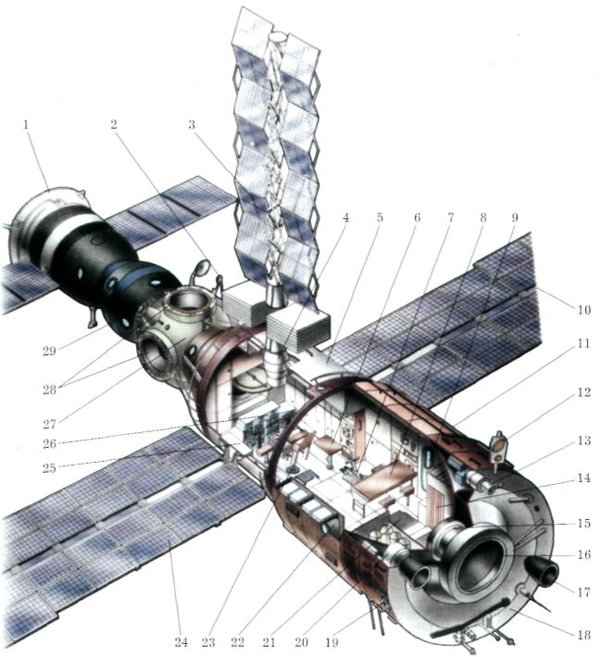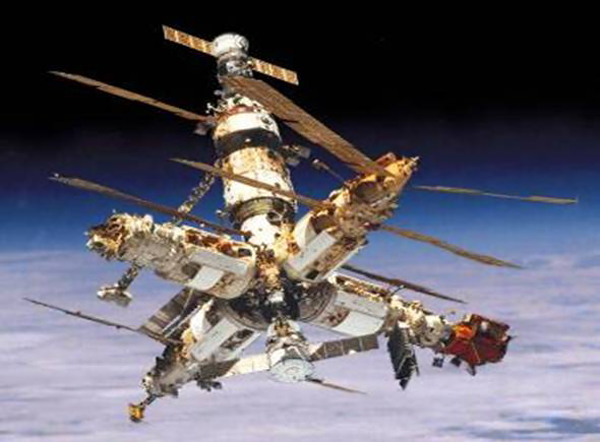Mir
The orbital station Mir is the first modular space station in the world. Fully assembled orbital complex includes: a base module (was launched in February 1986), an astrophysical module Kvant (April 1987), an extension module Kvant-2 (December 1989), a process module Kristal (June 1990), a research module Spectrum (May 1995), a research module Priroda (April 1996), a docking compartment, the Soyuz-TM transport vehicle and the Progress-M cargo vehicle. Progress-M is a more accomplished cargo vehicle which was designed on the base of the the Progress cargo vehicle and Soyuz-TM. The orbital station Mir is designed for long-term flights of 2-3 cosmonaut crews to perform technological experiments on the processes of semiconducting materials and medicines semiscale production as well as technical, biomedical, geophysical, astrophysical and other experiments and research. Mir was continuously in use, expeditions interchange was implemented on board the station. The station total mass (fully assembled) was more than 125 tons, the total volume of pressurized compartments - 400 cu. m.

Mir base module was launched on February 19, 1986. It was the foundation for a multipurpose ongoing modular complex (space station of the 3rd generation). As a part of the orbital station Mir was used for modules, manned transport vehicles and unmanned cargo vehicles docking as well as to provide necessary work and leisure facilities. Main hardware and equipment elements of Motion control and Power supply systems, Propulsion and Radio communication systems were located on the base module.
The first experimental module Kvant was docked to the base module in April 1987. It was designed for astrophysical and other scientific research.
Development of the extension module Kvant-2 started in 1982. The purpose of the module is to fit up Mir station with equipment and instruments as part of Life support system, EVA facilities, Power supply and Motion control systems. Besides, the extension module was designed to deliver fuel and other supplies. The module Kvant-2 docked with Mir station on December 6, 1989.
The process module Kristal was designed for the program implementation on semiconductor materials and biological products experimental production, scientific experiments and space technologies improvement as well as for docking with Buran spacecraft and Soyuz-TM crew rescue vehicle. Kristal module docked with Mir station on June 10, 1990.
The research module Spectrum was launched on May 20, 1995. Spectrum scientific equipment was designed to study the Earth's natural resources, upper atmosphere, space station’s outer atmosphere, geophysical processes of natural and artificial origin in near-Earth and outer space as well as in upper atmosphere, space radiation, biomedical research. The module consisted of a pressurized instrument-cargo and non-pressurized compartment.
Nature scientific-research module was launched on April 23, 1996. It’s main purpose is to study the surface and atmosphere of the Earth, the near-station atmosphere, influence of space radiation on human body and pure medicine production under zero gravity.
Under Mir 28 program there were carried out 28 prime expeditions and 9 visiting expeditions and were performed 8 dockings with Shuttle spacecrafts.
Duration of stay of prime expeditions on Mir station was more than 12 348 days. 16 international crew flights were implemented. Mir operation on orbit lasted from 22.02.1986 till 23.03.2001.

During its existence the station made 86,331 orbits around the Earth. Russian space station Mir ceased to exist on March 23, 2001.


